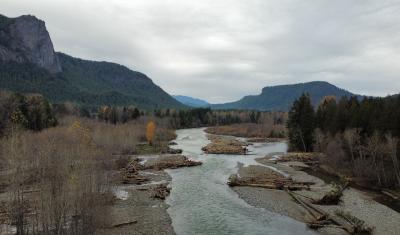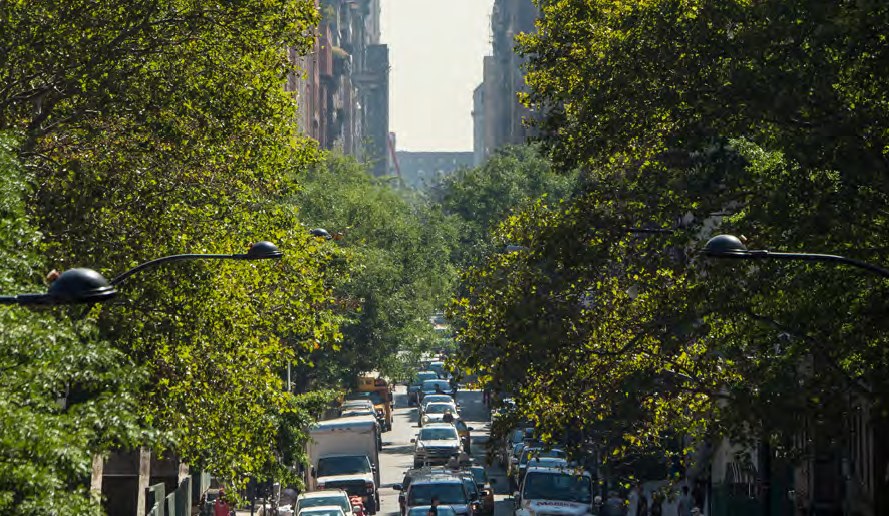Estimated reading time: 5 minutes
As the climate changes over the 21st century, the Puget Sound region’s urban forest will be affected by changing temperatures and precipitation regimes, leading to implications for the people who depend on its ecosystem services.
Climate change will affect the vulnerability and suitability of urban tree species in the Puget Sound region.
Climate change is increasingly being integrated into forest management to ensure that urban forests will continue to provide benefits to the people who live in urban communities as the climate changes. This report summarizes potential changes to the urban forest of the Puget Sound region under a range of future climates and determines the vulnerability of trees in planted landscapes to those changes.
Some tree species that are currently present may experience declines in habitat suitability under warmer temperatures and altered precipitation patterns. Climate change can also have indirect effects by changing insect pests, pathogens, and nonnative invasive species, as well as the probability, severity, and extent of severe storms. Tree species in the area will differ in their capacity to adapt to such stressors.
Puget Sound Region: Tree Species Vulnerability Assessment
This assessment analyzes potential changes to the urban forest of the Puget Sound region under a range of future climates and determines the vulnerability of trees in planted landscapes to those changes. The report details risks and potential impacts on 181 tree species in the full assessment.
Key Findings
Expand the accordions below to learn more about the findings from this assessment.
Plant hardiness and heat zones are geographic areas that define which species or cultivars are considered suitable for planting and survival. The plant hardiness zone map is based on minimum annual temperature and helps to identify plants that may or may not be adapted to withstand winter cold temperatures. Each hardiness zone is 10°F warmer (or colder) than the adjacent zone to its north (or south). It is significant that hardiness zones have migrated north by one-half to one full level since 1990 (USDA Forest Service, 2020).
The region is already above the minimum hardiness requirements for most temperate tree species and hardiness zones are not projected to change considerably . The Puget Sound Region is historically (1980-2009) in plant hardiness zones 8 (-12.2°C to -6.7°C) to 9 (- 6.7°C to -1.1°C). Future hardiness and heat zones were obtained from Matthews et al. (2018). Under the low climate change scenario, the hardiness zone is projected to stay in zones 8-9 in the Puget Sound Region by 2039 and shift completely to zone 9 by 2040-2069 (Table 1). Under the high climate change scenario, RCP 8.5, the hardiness zone is projected to shift completely to zone 9 by 2039 and remain in zone 9 through 2099.
The American Horticultural Society established heat zones for determining the upper temperature limits that trees are able to tolerate (Cathey 1997). The heat zone map is based on the number of days exceeding 86°F (30°C) and is used to determine heat stress on plants. The Puget Sound Region is historically (1980- 2009) in heat zone 2 (1 to 7 days exceeding 30°C). Under the low climate change scenario (RCP 4.5) the heat zone is projected to stay in heat zone 2 through 2039 and shift to zone 3 (>7 to 14 days exceeding 30°C) by 2040-2069, remaining in zone 3 through 2099 (Table 1). Under the high climate change scenario (RCP 8.5) the heat zone is projected to shift to zone 3 by 2039, zone 4 (>14-30 days exceeding 30°C) by 2040-2069, and zone 6 (>45-60 days exceeding 30°C) by 2070-2099.
Zone suitability was determined by the current and projected heat zones for the Puget Sound region through the end of the century. Trees were considered suitable if the following criteria are met for the species:
- minimum hardiness zone tolerance is less than or equal to the current hardiness zone,
- maximum hardiness zone tolerance greater than or equal to the projected hardiness zone,
- and heat zone tolerance is greater than or equal to the projected heat zone.
For the Puget Sound region, the heat and hardiness zone suitability results were the same under the low and high climate change scenarios because all species were considered suitable given the projected changes in heat zones and there is little projected change in plant hardiness zones. Under both scenarios, 101 (56%) of the assessed tree species are not expected to be suitable and 84 (44%) of the assessed tree species are expected to be suitable through the end of the century.
Heat and plant hardiness zone data provide information on potential changes in tree species habitat suitability across a range of projected extreme high and low temperatures. However, those analyses do not account for other climate-related impacts that may affect trees such as changes in flood regime, extreme weather events, insect pests, diseases, and nonnative invasive species. To understand the capacity of tree species and cultivars to adapt to these other effects of climate change, we relied on a scoring system developed by Matthews et al. (2011) called “modification factors” to determine adaptability scores.
Of the 181 tree species scored for adaptability, 25 species (14%) were found to have low adaptability, while the majority (107 species, 59%) were found to have moderate adaptability, and 49 species (27%) were found to have high adaptability.
Common species in the Puget Sound region with high adaptability scores include:
- red maple
- Norway maple
- kousa dogwood
- littleleaf linden
- American hornbeam
- sweetgum
- paperbark maple
- silver birch
- katsura tree
Tree species that received low vulnerability ratings tended to be susceptible to pests or diseases, were intolerant of a variety of disturbances and conditions (e.g., floods, wind, droughts, air pollution, restricted rooting conditions, temperature gradients), and had a narrow range in terms of urban sites and soil and temperature requirements.
Considering combined changes in heat and hardiness zones, most tree species assessed fall into the moderate-high vulnerability category (34%), followed by low-moderate (25%), moderate (18%), low (14%), and high (9%). Common species with low to low-moderate vulnerability considering both heat and hardiness zones include red maple, Norway maple, cherry plum, callery pear, big leaf maple, scarlet oak, green ash, American hornbeam, and European hornbeam. Common species with moderate-high to high vulnerability considering heat and hardiness zones include crabapple, Japanese maple, Japanese cherry, paperbark maple, red oak, Japanese snowbell, silver birch, katsura tree, rowan, and common hawthorn. Of these tree species, only big leaf maple is native to the Pacific Northwest.
Precipitation and temperature are changing at a global scale, and the rate is projected to increase in the coming decades. However, these changes will impact different locations in different ways, and these changes are best summarized at a local level for informed decisionmaking.
The average annual temperature in Seattle has increased by 0.4℉ per decade since 1960, and the average annual minimum (+0.3℉/decade) and maximum (+0.4℉/decade) temperatures follow a similar trend (NOAA, 2022). The temperature trend varies by season, increasing more in spring and summer (March through August, +0.5℉/decade) than in fall or winter.
Annual mean temperature is projected to increase by 5.0℉ by the end of the century under a low climate change scenario (RCP 4.5) and by as much as 8.6℉ by the end of the century under a high climate change scenario (RCP 8.5).
Annual precipitation in Seattle has increased by over 0.5 inches per decade since 1960. Precipitation has increased the greatest in September to November (+0.41 inches/decade) followed by March to May (+0.35 inches/decade). Precipitation has decreased overall from June to August (-0.16 inches/decade) as well as December to February (-0.04 inches/decade).
Precipitation is projected to increase under both low (RCP 4.5) and high (RCP 8.5) climate change scenarios through the end of the century in the winter, spring, and fall, while decreasing in the summer by as much as -0.6 inches. Annual precipitation is projected to increase by 2.1 inches by the end of the century under a low climate change scenario, and by as much as 3.2 inches by the end of the century under a high climate change scenario.
The tree species vulnerability list is not a recommended planting guide and should be combined with knowledge in the region as well as additional factors of consideration such as allergenicity, wildlife and cultural values, biodiversity goals, public health considerations, differences in decisions across ownerships and land uses, nursery supply, the contribution of urban trees to green infrastructure, impacts of urban forestry decisions on equity and environmental justice, and influences on planning and partnerships, and local planting lists.
When evaluating the adaptive capacity of a particular urban forest, considerations could include: biological factors such as the amount of biological or genetic diversity of urban forest; economic factors such as the amount of funding available to support urban forestry efforts; organizational factors such as policies and the number of trained staff to do the work; and social factors such as support from the community to assist with tree care and planting. Ecological adaptive capacity factors, such as species diversity, connectivity, age class diversity, and genetic diversity, are also important to consider.
Although we do not make recommendations for how management should be adjusted for projected changes, a separate document, Forest Adaptation Resources: Climate Change Tools and Approaches for Land Managers 2nd edition (Swanston et al. 2016), has been developed to assist forest managers in a decision-making process to adapt their land management to projected impacts. An additional report , Climate Adaptation Actions for Urban Forests and Human Health (Janowiak et al. 2021), provides information for optimizing the climate and health outcomes of urban forestry projects and provides professionals working at the intersection of climate, public health, and urban forestry with resources to support climate adaptation planning and actions.
-
Northwest Vulnerability Assessment

-
Climate Adaptation Menu for Urban Forests and Community Health


